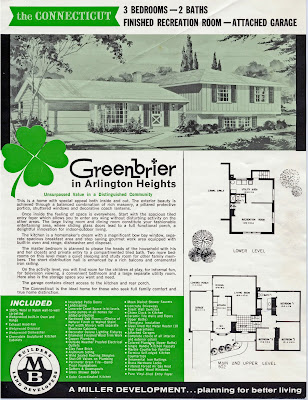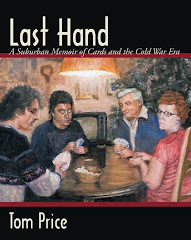In a little over a week the students of many elementary schools will march around the perimeter of their school dressed in their Halloween costumes. It would be unthinkable today to wander off of school grounds running the risk of some catastrophe that could befall a student under the school’s care. But that wasn’t always the case. The brief footage here comes from Halloween 1969 as the students of Greenbrier Elementary School
Friday, October 22, 2010
Wednesday, June 9, 2010
An Excerpt for Father's Day
 The book, Last Hand: A Suburban Memoir of Cards and the Cold War Era, takes a look back at American suburban life during the days of the Cold War. The book is also about family and the relationships between those family members. In the course of the book the reader becomes part of the family. As Father's Day is approaching I wanted to share an excerpt that captures just one aspect of the relationship between a father and his sons. Just click fullscreen for a better view.
The book, Last Hand: A Suburban Memoir of Cards and the Cold War Era, takes a look back at American suburban life during the days of the Cold War. The book is also about family and the relationships between those family members. In the course of the book the reader becomes part of the family. As Father's Day is approaching I wanted to share an excerpt that captures just one aspect of the relationship between a father and his sons. Just click fullscreen for a better view.Chapter 6 a Break From the Action SP Excerpt
Friday, May 14, 2010
Book Reading and Signing
Date: Saturday, May 22, 2010
Time: 3:00pm - 6:00pm
Location: Arlington Heights Historical Museum, 110 W. Fremont St. in Arlington Heights
Friday, May 7, 2010
Selling Suburbia II
I write about the development of the Arlington Heights subdivision, Greenbrier in the book Last Hand: A Suburban Memoir of Cards and the Cold War Era. The subdivision became another character in the book as the community changes over time. Below are images from the marketing packet I described in my previous post. They show the models of the available homes in the later half of the Greenbrier development. Miller Builders made very similar models in other developments in other suburbs around the Chicago area. Click on the images for a closer view. If you lived in Greenbrier you just might find your house.
Tuesday, May 4, 2010
Selling Suburbia
Recently I began preparing my thoughts for the upcoming book discussion and signing at the Arlington Heights Historical Museum the final weekend of the exhibit Gone but Not Forgotten: Lost Arlington Heights (http://www.ahmuseum.org/Gallery/index.htm) scheduled for May 22 at 3 pm.
The description of the exhibit seemed to fit well with the theme of my book:
The family’s move in the early 1960s coincided with a major shift in history of Arlington Heights as the village was evolving from a small town outside of Chicago to one of the city’s fastest growing suburbs. In the chapter “The New Suburbia” I write about the changes taking place northwest of Chicago. During the late 50s and early 60s a number of towns became full blown suburbs of the city. It was during that period that Arlington Heights grew 640% from its 1950 population of 8,768 to its 1970 population of 64,884. The growth changed Arlington Heights and the face of the community.
The time period described in the book was a unique as the small town atmosphere blended with the newly developed land. The subtitle to the book “A Suburban Memoir of Cards and the Cold War Era” is very fitting. Life in the “New Suburbia” was new and fresh, yet cultural life remained open and free for the kids growing up in the area. Some elements of small town life remained such as family owned businesses and shops adding to the positive flavor of small town life to the experiences of the new suburban kids. Time, of course, would change all of that.
Shortly after the book was released an old friend and classmate of mine Bill Westfall contacted me with a sort of treasure. An old neighbor of his had kept some of the original marketing material from Miller Builders (the developer who built Greenbrier as detailed in the book) and had given Bill’s parents the material when they moved away. Below are elements of that material that capture the “New Suburbia” feeling. The material comes from about the mid-point in the subdivision’s development (1965-66 timeframe). I will post some more in the days to come. Click on the images for a closer view.
The description of the exhibit seemed to fit well with the theme of my book:
“Throughout our community’s history many businesses, homes, schools, and other public spaces have been razed, or become victims of age. Our sense of community is often tied to these locations, which now reside only in our memories. Every now and then it is important to revisit these places in order to help us understand where we are today. Progress has changed Arlington Heights since it was first called Dunton in 1854, and progress will continue to shape the future of our community.”The book Last Hand: A Suburban Memoir of Cards and the Cold War Era isn’t really meant to be a history of Arlington Heights but rather the story of a changing community, culture, and country. The story also details the transition from city life to suburban life as the family moves from Chicago to Suburbia.
The family’s move in the early 1960s coincided with a major shift in history of Arlington Heights as the village was evolving from a small town outside of Chicago to one of the city’s fastest growing suburbs. In the chapter “The New Suburbia” I write about the changes taking place northwest of Chicago. During the late 50s and early 60s a number of towns became full blown suburbs of the city. It was during that period that Arlington Heights grew 640% from its 1950 population of 8,768 to its 1970 population of 64,884. The growth changed Arlington Heights and the face of the community.
The time period described in the book was a unique as the small town atmosphere blended with the newly developed land. The subtitle to the book “A Suburban Memoir of Cards and the Cold War Era” is very fitting. Life in the “New Suburbia” was new and fresh, yet cultural life remained open and free for the kids growing up in the area. Some elements of small town life remained such as family owned businesses and shops adding to the positive flavor of small town life to the experiences of the new suburban kids. Time, of course, would change all of that.
Shortly after the book was released an old friend and classmate of mine Bill Westfall contacted me with a sort of treasure. An old neighbor of his had kept some of the original marketing material from Miller Builders (the developer who built Greenbrier as detailed in the book) and had given Bill’s parents the material when they moved away. Below are elements of that material that capture the “New Suburbia” feeling. The material comes from about the mid-point in the subdivision’s development (1965-66 timeframe). I will post some more in the days to come. Click on the images for a closer view.
Labels:
Arlington Heights,
Greenbrier,
Miller Builders,
Suburbs
Friday, April 23, 2010
The Wish Book
In the book, Last Hand: A Suburban Memoir of Cards and the Cold War Era, I write about using the Sears Wish Book for my Christmas list inspiration. Although I have a few old copies of the Wish Book, I’ve decided to attach a few pages from the 1975 catalog. If you want to write down your memories of what you wanted as a child, I might be able to find a matching page. Some of the catalogs (JC Penny, Spiegle, Wards and Sears) date back to the mid-1940s. Click on the images for a closer view.
Thursday, March 4, 2010
Better Late Than Never
Long before becoming a visual effects artist, my brother, Steve Price, went to Buffalo Grove High School. And it was during his senior year that he was tasked with designing the cover of the yearbook. I’m not sure if he came up with the idea of modeling the yearbook after the board game Life but it wouldn’t have been unusual for his creative personality. I do know he put forth a lot of effort to make a pretty cool cover design, artwork and captions for the game. What makes the design special is that it truly captures the spirit of high school life at Buffalo Grove during those days.
Of course, only people who were staff or students during the 1979 school year (or had siblings who were) had a chance to see the yearbook. For that reason I’ve posted copies of Steve’s work here for others to view. Click on the image for a closer view.
Well, having watched Steve work on the cover I think that would have applied to him. However, the funny thing is the one person who wasn’t credited for working on the book was Steve. In fact, the only sign Steve worked on the cover was his signature on the back cover image. So, I guess, I’m giving him his proper credit now.
Of course, only people who were staff or students during the 1979 school year (or had siblings who were) had a chance to see the yearbook. For that reason I’ve posted copies of Steve’s work here for others to view. Click on the image for a closer view.
There is an ironic side story that goes with the yearbook. It seems the Editor-in-chief, Nancy Wetzell, was disappointed with the lack participation of the student body in the effort to produce the yearbook that year (apparently a number of students quit during the school year) and in the Editor’s Statement wrote, “Students should be more willing to give of themselves and their talents for the betterment of the entire school.”
Well, having watched Steve work on the cover I think that would have applied to him. However, the funny thing is the one person who wasn’t credited for working on the book was Steve. In fact, the only sign Steve worked on the cover was his signature on the back cover image. So, I guess, I’m giving him his proper credit now.
Labels:
Arlington Heights,
Art,
Buffalo Grove High School,
Steve Price
Subscribe to:
Posts (Atom)





















